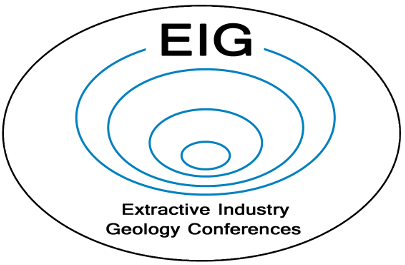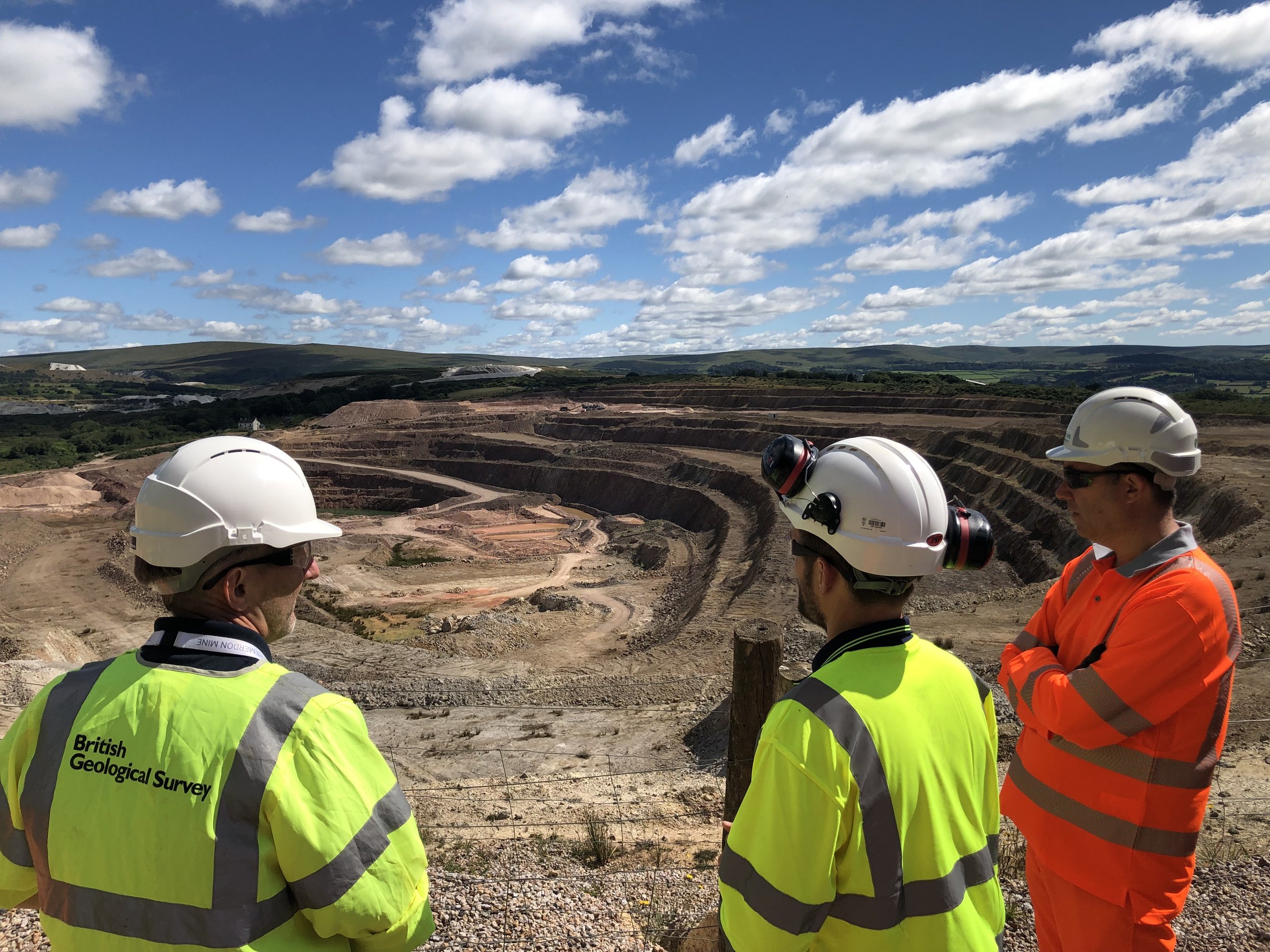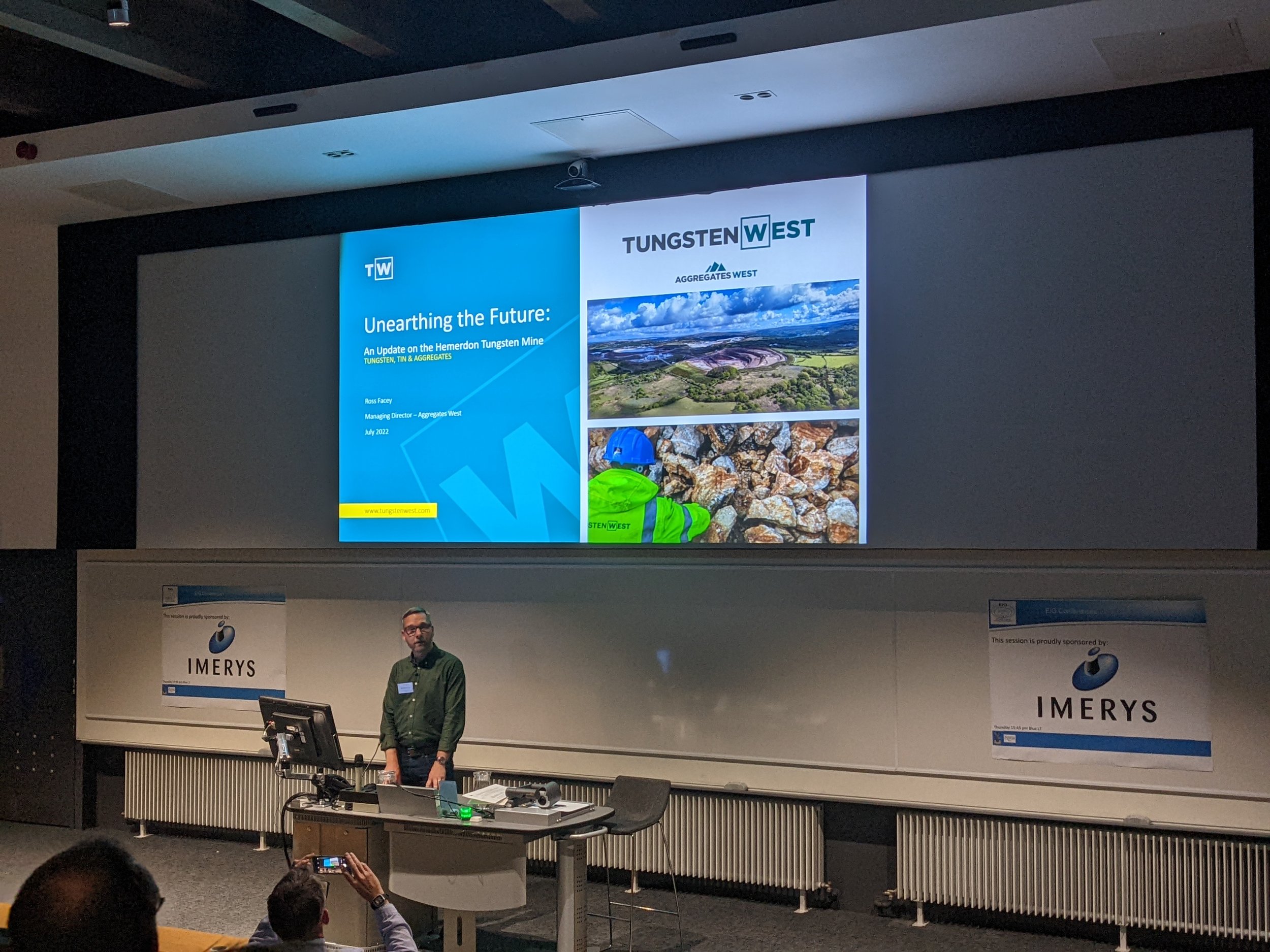47 Years of the EIG: 1978 to 2025
The EIG Conference has been held almost biennially since 1978 and each event has built on the success of those which preceded it. It is now firmly established as the principal event for sharing knowledge, scientific research and good practice in the field of applied geology within the UK minerals industry. In recent years the EIG Conference has become a fully independent organisation, run by a committee of volunteers drawn from the extractive industry, academia, consultancy and other interest groups. On its 30th anniversary in 2008, building on the secure financial footing built up by the success of previous events, the EIG Conference became a Company Limited by Guarantee, with a board of directors drawn from the organising committee. Next year’s conference will mark the 48th anniversary, but here’s how it all began:
-
9-10th March
Organised by an ad hoc Committee, chaired by Colin Bristow, on behalf of the Geological Society and the Institution of Mining and Metallurgy. The geologists attending the Regional Groups of the newly formed (1977) Institution of Geologists included a sizeable community of geologists working in the 'real' onshore extractive industry in the UK whose interests were poorly catered for by the existing learned societies/professional institutions. This first EIG meeting was an attempt to cater for this group. Two-day meeting, ca. 18 papers, with no field excursions, just over 200 attended: it confirmed the need for this type of meeting. Report of the meeting ('Extractive Industry Geology' by P.C. Wright) published in the British Geologist, July 1978. Volume 4, Part 3, pages 67-68.
-
16-17th March
Organised by an IMM Committee. The high overhead cost associated with using the IMM Conference Secretariat proved to be something of a handicap. Several field excursions. Some papers published in Trans. lMM (Applied Earth Science).
-
21-22nd March
A very successful meeting organised by Rick Brassington, with a small committee set up by the Institution of Geologists. Several field excursions. It featured the first proper Trade Exhibition, which showed that this was a good way of helping to finance the event, as well as providing interest. Publication: Prospecting and Evaluation of Non-metallic Rocks and Minerals, eds. K. Atkinson and R. Brassington, published by the Institution of Geologists, 1983.
-
25-26th March
Organised by Ansel Dunham, David Highley and Caroline Symons on behalf of the Geological Society. Proceedings published in 1988 by the Industrial Minerals Unit of the University of Hull on behalf of the Geological Society: 'Extractive Industry Geology 1985' edited by P. W. Scott. Visited Tarmac laboratories and Buddon Wood (later Mountsorrel) quarry courtesy of Redland Aggregates.
-
23-24th March
Organised by an IMM committee. Almost the “Ghost EIG’ in that no-one can remember anything about it. The field trips were to Chelford silica sand quarry and the (then) Steetley quarries and brickworks in the Etruria Marl. Some papers were published in Trans. IMM (Applied Earth Science).
-
17-19th April
Well-attended meeting. Organised by an IG committee chaired by Bill Barrett. Sponsored by IG, Geological Society, IMM and MIRO. Proceedings published by the Institution of Geologists: 'Extractive Industry Geology', edited by Bill Gaskarth and A.C. Lumsden. Opencast coal and a major quarry visited.
-
12-14th April
Organised by Ansel Dunham and Peter Scott on behalf of the Geological Society. Proceedings not published. Redland Aggregates’ Mountsorrel Quarry and ECC Quarries’ Croft quarries visited.
-
18-19th April
Organised by Dick lneson, advised by an IMM Committee. Not well attended (60), possibly due to the high cost of the IMM Conference Secretariat and lack of publicity. Some papers published in Trans. IMM (Applied Earth Science).
-
15-18th April
An EIG in name only, as it was made part of the huge Applied Geoscience Conference and was organised by a committee of the Engineering Group of the Geological Society. That said there were 48 EIG papers presented to an audience drawn from 640 delegates and a book of abstracts was published. Notable also for a screening of the relatively recent “Jurassic Park” film to an audience of seasoned geoscientists.
-
1-2nd July
Held at Crossmead Conference Centre and organised by Colin Bristow and Peter Scott of Camborne School of Mines, University of Exeter on behalf of the IMM. Single field excursion to Westleigh and Hillhead quarries. Some papers published in Trans. IMM (Applied Earth Science). Approximately 170 registrants. An ongoing committee was set up to oversee the organisation of future EIGs; the lack of such a committee had seriously hindered the continuity of the organisation from one EIG to the next, as it had been left to each sponsoring body to set up a new committee each time.
-
7-12th May
Joint with the North American 36th Forum on the Geology of Industrial Minerals. Organised by Peter Scott and Colin Bristow of Camborne School of Mines, University of Exeter on behalf of the Geological Society. The first Ansel Dunham Memorial lecture was given by Richard Fox. Seven field excursions, plus an extensive social and spouse programme. 264 registrants. Proceedings published in 2002 by the Geological Society as 'Industrial Minerals and Extractive Industry Geology'.
-
7-10th April
A well run 'comfortable' conference with field trips to a stone merchant’s in Matlock, an underground gypsum mine, and a major granite quarry. Over 100 delegates and trade stand attendees. The second Ansel Dunham Memorial lecture was given by David Highley of the BGS. Some papers were published in the IMM Transactions. Organisers Duncan Wardrop of Lafarge Aggregates and Kip Jeffrey of Leicester University chaired this first financially independent EIG conference.
-
2-4th September
Another very well attended event with an excellent atmosphere. Sufficient papers were received to necessitate parallel sessions in a lecture theatre and an elegant music room, and one young speaker was offered an MSc place on the strength of his paper. Subject matters were wide ranging with some deliberately lesser-known areas of work such as mineral products in food. The Ansel Dunham Lecture was given by Professor David Manning. Field trips were undertaken to a major limestone quarry and a smaller specialist roadstone quarry, and to Cleveland Potash. Organiser Professor Geoffrey Walton was assisted by a well-established committee and (for the first time) by EIG's own website and bank account. Proceedings of the conference were published by MIRO in 2005.
-
14-17th June
In the shadow of Arthur’s Seat, this year saw the first excursion of EIG north of the border. Another excellent event with around 170 delegates and parallel sessions used again to support the number of papers. The conference opened with a guided tour of the new Scottish Parliament building. Professor Peter Scott of Camborne School of Mines gave the Ansel Dunham lecture, the delegates were piped across the campus to the conference dinner, and a Scottish theme was maintained throughout. Field trips included the classic Hutton’s Unconformity at Siccar Point, a large cement operation, and silica sand and aggregate quarries in Fife. The conference chairman was Adrian Charters of Aggregate Industries and the Proceedings, which included most of the papers, were published by EIG in 2008, edited by Geoffrey Walton.
-
25-28th June
Marking the first EIG visit to Wales, almost 200 delegates registered (a record for an EIG-only conference at that time) and parallel sessions were able to accommodate a total of 45 oral presentations. Nigel Jackson of the QPA and the CBI Minerals Group delivered the Ansel Dunham Lecture and delegates were treated to a guided tour of the Welsh Assembly Government building in Cardiff Bay, and to a conference dinner in the Grand Hall of the National Museum of Wales, accompanied by a live harp musician. Field trips included the Forest of Dean coal mines, Taffs Well quarry and the Ffos-y-Fran opencast coal site. The conference chairman was Alan Thompson of Cuesta Consulting Ltd. The majority of the papers presented at the conference were published in the Proceedings, edited by Peter Scott and Geoffrey Walton.
-
8-11th September
EIG was back in England after 6 years. As in 2008, there were over 40 oral presentations, many in parallel sessions. With over 160 delegates, a very good show of support from sponsors and a full trade exhibition on the back of two years of severe UK economic downturn. The Ansel Dunham Lecture was given by Professor Geoffrey Walton. Icebreaker reception at the Spinnaker Tower and conference dinner aboard HMS Warrior accompanied by dulcimer music. Field trips to Michelmersh Brick & Tile, Brightling Gypsum Mine and a full day of classic and applied geology on the Isle of Wight. The conference chairman was Colin Comberbach. The Conference Proceedings, edited by Geoffrey Walton and Emily Hunger were being printed in advance of the 2012 conference.
-
5-8th September
The 17th EIG headed north of Liverpool to south west Lancashire and proved yet again to be another highly successful conference. Attended by over 150 delegates it demonstrated the keen interest of everyone involved and the verve that has built up in recent years in this important sector of the mineral industry. 42 papers were presented on everything from building stones to shale gas. The Ansel Dunham Lecture was delivered by Andrew Bloodworth of the British Geological Survey on the past and future extractive history of Britain. Edge Hill is a campus university and the icebreaker reception, the conference dinner and all the lectures were held within close proximity on the leafy green site. Field trips included visits to Sibelco's silica sand quarry at Chelford; Hanson's cement works and limestone quarry at Clitheroe, Tarmac's high PSV gritstone quarry at Arcow in upper Ribblesdale; and Cemex UK's quarries at Roan Edge (high PSV) and Shap Pink (granite) - both in Cumbria. The 2012 Conference Chairman was Craig Arditto of Tarmac Limited. Half of the presentations were written up and included (after editing and peer review) in the Conference Proceedings, edited by Emily Hunger, Teresa Brown and Gerry Lucas. These were published in May 2014, in advance of the 2014 conference
-
11-14th June
For the first time since Edinburgh, the EIG returned to Scotland. This conference was also a special opportunity to partner with our North American colleagues from the FGIM and hold a joint conference. With the American contingent in the UK for the conference, this meant there were additional field trips to take in the geology of North East England and the Scottish borders and, following the conference, a trip to the Highlands of Scotland. Regular field trips were also available including Fife, Silica Sand and Aggregate Industries’ coastal ‘super-quarry’ Glensanda. A spouse programme was also put together for the partners of the FGIM delegates. There were 175 delegates that made the trip to St Andrews and 50 oral presentations. As always there was a tremendous amount of support from sponsors and a full complement of trade exhibitions; once again demonstrating the value of the EIG conferences even during difficult economic periods. The conference was yet again able to offer delegates parallel sessions. The Ansel Dunham lecture was given by Duncan Wardrop. The ice breaker was at the St Andrews Museum (MUSA) and conference dinner was held in the lower conference hall. This was followed by a first for the EIG, a Ceilidh in the upper hall. The conference chairman was Clive Mitchell of BGS.
-
6-8th September
With an enjoyable nod to geological and academic history EIG 2016 took place on the comfortable Birmingham University campus, one of the original redbrick Universities and home of the Lapworth Museum. Our Chairman was Simon McCurdy. The Ansel Dunham lecture was given by Alan Cobb wherein he addressed the fascinating history of the Aberfan disaster of 1966. A packed programme included 40 other papers with a mix of plenary and parallel sessions taking place in freshly refurbished lecture theatres. Some high-quality posters that are an important part of EIGs were also viewed in the refreshment areas. A wonderful conference dinner was held in the Great Hall in the Aston Webb building followed by some dancing(?) to a live swing band. The formal conference was concluded by a private viewing of the world famous Lapworth Museum. A record attendance of 217 delegates took part in the conference.
-
12-14th September
Hosted by the august, gracious and historic University of Durham and Chaired by Nick Horsley the 2018 conference was EIG at its’ best. A programme of 31 papers were given in a mix of plenary and parallel sessions together with a choice of 5 field trip locations. An opening address from Professor Jon Gluyas, Dean, welcomed us to the university and noted amongst other things that the founder of Oxford University was a Durham man. Alan Thompson delivered a thought provoking Ansel Dunham lecture on the balances that have to be struck in developing sustainable mineral operations. A typically lively conference dinner took place in Durham Castle, no less, with a generous charity raffle in aid of the Great North Air Ambulance. An excellent cohort of student helpers provided great logistical assistance to the 170 delegates. Proceedings were published edited by Paul Anderson and his team.
-
3-4th November
New for presenters and delegates alike was the first EIG foray into virtual conferencing, driven by the Covid 19 pandemic and a desire to keep the EIG momentum in strange times. The format was 2 part-days with around 170 delegates registering and 100 attending for some of the event. The conference, chaired by Simon McCurdy, was free to attend funded by accumulated EIG funds as a means of giving back to the community in difficult circumstances. 20% of the delegates were new to EIG and feedback was very positive.
-
6-9th July
This much deferred conference chaired by Simon McCurdy saw us back at the University of Exeter on behalf of Camborne School of Mines and was enhanced by superb weather. Many friends and colleagues had not seen each other for over 4 years and the reunions were quite emotional – the special EIG spirit was very evident as friendships were refreshed and new friendships were made. 36 diverse papers were given taking delegates across the world but with a focus on transition minerals essential for the move towards zero Carbon. The Ansel Dunham lecture was given by Dr Karen Hanghøj, Director of the British Geological Survey. 177 delegates, 14 trade stands, exceptionally generous sponsors, field trips to Westleigh Quarry and Lee Moor secondary aggregate site and Hemerdon Tungsten mine all contributed to an outstanding EIG. A record breaking raffle supported the Devon Air Ambulance and Dementia UK.
-
3-6th September
The second in person conference since the Covid pandemic, chaired by Alex Finlay with Deputy Chair Emma Goode. 170 delegates enjoyed the unique EIG spirit and a packed technical programme covering basic techniques through to space rock research. 16 trade stands and generous sponsors supported the exceptional value for money of the conferences. Field trips were taken to Drax Power Station, Broomfleet Quarry and an atmospheric Spurn Point. The Ansel Dunham lecture was given by Hull alumnus and long standing EIG committee member Adrian Charters, outlining his personal journey in geoscience technology from slide rule to state of the art drone surveying. A great contribution from young early years professionals was notable as was an excellent conference dinner. Another raffle record was broken with over £2,500 raised for the RNLI and Hull Children’s University.
ADDITIONAL ONE DAY EVENTS
In 2012, EIG Conferences decided to start holding a series of one-day technical meetings in the years between the biennial conferences, focusing on items of current interest. Those held so far have been:
-
19th June
A meeting on ‘Rockfall in quarrying’ was held following recent Dangerous Occurrences. The venue was the Gaydon Conference Centre, Warwickshire with an attendance of 90 delegates, 8 trade stands and 8 speakers. A good proportion of those attending were from quarry operators. Geoffrey Walton, assisted by some of the speakers, organised the meeting.
-
17th June
This meeting was held at the Stratford Manor Hotel in Warwickshire and covered ‘Surface water, groundwater and flooding in mines and quarries.’ It followed recent serious flooding and inrush incidents and much concern over planning for working in floodplains. Around 100 attended, with 11 exhibitors and 9 speakers. There were extended opportunities for questions and discussion. An organising group chaired by Geoffrey Walton managed the meeting.
-
21st June
This meeting was held again at the Stratford Manor Hotel in Warwickshire and once again was managed by Geoffrey Walton, with help from one or two others. The central theme was Exploration and Investigations of mineral reserves, covering practice, recent developments and techniques. The meeting had eight invited speakers and was split into four sections: Health and Safety and planning regulations for exploration and investigations; Mineral quality and resource and reserve reporting; New and developing methods of identifying and measuring resources; and Practice and problems.
-
19th June
Organised by Geoffrey Walton and Craig Arditto the returning subject matter of geotechnics in extractive sites was the focus of this valuable CPD workshop event. Slope stability design, engineering techniques, lagoon safety, Eurocodes, UK regulations and HSE updates were addressed. The Stratford Manor Hotel in Warwickshire once again hosted the workshop. The attendees noted with great sadness the passing away of Jackie Smith from the BGS who was a wonderful supporter of EIG, a ray of sunshine and the welcoming face at registration for hundreds of EIG delegates over the years.
-
14th September
The Stratford Manor Hotel again hosted the technical event organised by Craig Arditto and a team of EIG stalwarts. The subject was “Quarry design for the Future, NOW” and reflected designing for Biodiversity Net Gain, less certain water resources or too much water, and Carbon reduction. Ten papers were given covering these areas. Support was gratefully received from sponsors and exhibitors on 8 trade stands. A record number of over 100 delegates attended causing the limit on headcount to be extended twice.
PROCEEDINGS ARCHIVE
EXETER 2022
Proceedings to be published
VIRTUAL 2020
DURHAM 2018
BIRMINGHAM 2016







